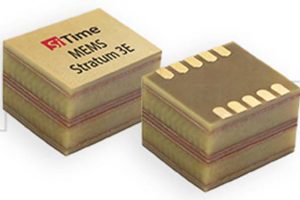
“No further thermal precautions are needed, additional covers are not needed,” the company told Electronics Weekly. “The physical footprint is 9 x 7 x 3.73mm, and the device will deliver the listed specifications.”
The technology behind the oscillator family has been dubbed the Epoch Platform, and it is intended to produce oscillators capable of meeting Telecordia Stratum 3E precision for phone central office and mobile infrastructure and, “for telecom applications, there is a system-wide requirement for all nodes to be within ±1.5μs as specified by the 3GPP standard. This is the standard metric most of our customers are using”, said SiTime.
| stability | frequencies | hold-over | |
| SiT5801 | ±3, 5ppb | 10 – 60MHz | 4 to 6 hours |
| SiT5802 | ±3, 5ppb | 60 – 220MHz | 4 to 6 hours |
| SiT5811 | ±1ppb | 10 – 60MHz | 8 to 12 hours |
| SiT5812 | ±1ppb | 60 – 220MHz | 8 to 12 hours |
Epoch has four elements: the mems oscillator, temperature sensing “with 100% thermal coupling that
enables fast temperature tracking under airflow and temperature changes”, said the company, the heater and “mixed-signal circuits with on-chip regulators, a temperature to digital converter and a low-noise PLL”.
Regarding the mems, it said: “Most of an oscillator’s aging is derived from two sources: changes in the stress properties of the resonator, and the packaging. SiTime’s process leads to completely smooth and
uniform resonators, without the stress defects that lead to resonator aging. Innovations in package engineering minimise changes in the stress properties of the key oscillator components including the CMOS
and attach materials.”
Eight hours of hold-over is available – measured by temperature cycling throughout the test period, or 12 hours with aging compensation. “The aging of an oscillator is predictable, and can be compensated for extended holdover performance,” explained the company, which puts it around ±0.08ppb/day.
On the subject of accuracy: Allan deviation under airflow is 5 x10-12 at 10 seconds averaging time, and time-to-stability is one minute.
Any frequency between 10 and 220MHz is available, programmable up to six decimal places.
Electronics Weekly asked about programmability (there are I2C and SPI interfaces), and so far SiTime has answered: “These are standard products which will be made available to all customers, there is no need for custom products” and “device-level programmability is for the manufacturer – SiTime’s CMOS processes allow us to meet customers’ specific requirements with low lead times.”
Further clarification has been requested as data sheets are currently NDA-only – they are scheduled to be made public early in 2024, which is when the oscillators will be released to production.
Operation is over -40 to 95°C, and consumption is 420mW from a choice of 2.5, 2.8 or 3.3V.
 Electronics Weekly Electronics Design & Components Tech News
Electronics Weekly Electronics Design & Components Tech News



